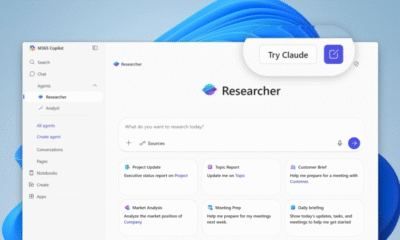Security
Empowering AI in the Field: Advancing Technology at the Tactical Edge

In the realm of national security, the U.S. Department of Defense (DoD) is increasingly embracing artificial intelligence (AI) as a pivotal component. However, the challenge lies in translating advanced research into practical tools that can be utilized in real-world scenarios. AI-driven systems have the potential to revolutionize defense operations, whether it be through autonomous vehicles, predictive maintenance, accelerated intelligence gathering, or enhanced decision-making on the battlefield. Yet, harnessing this potential necessitates a computing infrastructure that is agile, secure, and scalable to align with the missions it serves.
This necessity is particularly pronounced at the tactical edge, where split-second decisions can be the difference between success and failure. Implementing AI in such high-pressure environments requires not only the right algorithms but also the appropriate architecture. This is where hybrid cloud technology plays a crucial role, bridging the gap between cutting-edge supercomputing capabilities and operational systems without compromising on security or performance.
The Crucial Role of Infrastructure in AI-Driven Defense
The adoption of AI within the DoD has experienced a significant surge in recent years, propelled by strategic initiatives like the Combined Joint All-Domain Command and Control (CJADC2) and the Replicator Initiative. In 2025 alone, the DoD earmarked $25.2 billion—approximately 3% of its $850 billion budget—for programs integrating AI and autonomous systems.
However, transitioning AI from a theoretical concept to operational readiness poses considerable challenges for agencies. These hurdles encompass technical complexities, regulatory constraints, handling sensitive data, bandwidth limitations, sporadic access to computing resources, and stringent cybersecurity prerequisites.
Traditional high-performance computing (HPC) environments often lack the adaptability required to swiftly respond to evolving mission requirements. On the other hand, commercial cloud platforms, while flexible, may not inherently meet the federal Impact Level 5 (IL5) security standards. Hence, the emergence of hybrid IL5-authorized platforms is instrumental in bridging the divide between capability and compliance.
To transition AI from the laboratory to the field, the infrastructure must facilitate real-time inference, dynamic retraining, and seamless model sharing across diverse environments. This entails meeting the high-throughput demands of training and simulation while enabling low latency and resource-efficient execution at the tactical edge.
A new wave of IL5-authorized hybrid cloud platforms blends the performance of on-premises DoD supercomputers with the scalability of commercial cloud services, all while upholding stringent controls for managing Controlled Unclassified Information (CUI) and International Traffic in Arms Regulations (ITAR) workloads.
One such platform, recently granted IL5 Provisional Authorization by the Defense Information Systems Agency (DISA), empowers defense teams to securely deploy AI and simulation workloads across major cloud providers like AWS, Azure, Google Cloud, and the DoD High Performance Computing Modernization Program (HPCMP) Defense Supercomputing Resource Centers (DSRCs). Its security posture, inherited from its authorization, eliminates redundant compliance reviews, drastically reducing the time required to achieve operational readiness.
This model offers benefits beyond enhanced security. Hybrid platforms unlock a spectrum of capabilities that directly bolster mission-critical advantages:
- Seamless Data Movement: AI models developed in secure cloud environments can seamlessly transition to forward-operating systems without breaching the IL5 boundary, ensuring continuity between development, testing, and deployment phases.
- Elastic Compute Scaling: Mission teams can dynamically distribute workloads across cloud and supercomputing infrastructures based on real-time needs, whether for autonomous navigation simulations, ISR data analysis, or swift response planning.
- Cost and Resource Efficiency: Infrastructure-as-code and fine-grained usage monitoring enable federal agencies to gain unparalleled visibility and control over their compute expenditure, a pivotal advantage in budget-constrained settings.
- Rapid Deployment: Pre-authorized environments empower mission owners and integrators to swiftly establish secure AI-ready infrastructure, bypassing traditional provisioning bottlenecks.
The potential of hybrid AI is already materializing across pivotal domains:
- Autonomous Systems: Training models for autonomous drones or unmanned vehicles demands substantial compute power. Hybrid platforms facilitate large-scale training in the cloud, with secure real-time inference capabilities deployed at the tactical edge.
- Intelligence, Surveillance, and Reconnaissance (ISR): Processing sensor data necessitates low-latency, custom models. Hybrid environments ensure that ISR workflows remain agile and secure across dispersed teams and environments.
- Predictive Maintenance: AI-powered diagnostics can preempt equipment failures in operational theaters. Hybrid cloud solutions enable algorithms to glean insights from fleet-wide data and disseminate updates to localized systems, ensuring reliability in challenging environments.
Transforming AI Potential into Operational Advantage
As the DoD intensifies its digital modernization endeavors, the demand for scalable, secure, and operationally resilient infrastructure in real-world operations becomes increasingly critical. IL5-authorized hybrid cloud environments represent a significant stride forward, laying a trusted foundation for advancing AI innovation driven by mission imperatives.
These platforms empower the transition of AI from theoretical promise to tangible operational benefit, bridging the gap between theoretical concepts and practical applications.
In this evolving landscape, hybrid cloud transcends being merely an IT enhancement—it emerges as a tactical instrument with tangible operational implications. In scenarios where time is of the essence and data steers decisions, AI powered by secure hybrid cloud furnishes the DoD with the edge needed to operate at the speed demanded by contemporary challenges.
Matt Archuleta, the Vice President of Operations at Parallel Works, is at the helm of the ACTIVATE control plane for hybrid multi-cloud computing resources. A distinguished U.S. Army Green Beret and investor, Archuleta brings to the table mission-oriented leadership, profound strategic acumen, and a proven track record of operational expansion.
An ex-U.S. Army Special Forces officer and Infantry officer, Archuleta led elite teams in West Africa and the Middle East. His leadership in Afghanistan earned him the Bronze Star, with his contributions to national defense and business receiving recognition in The New York Times and Poets & Quants.
Archuleta boasts an MBA from the Yale School of Management, an MPA from Harvard Kennedy School, and a B.S. from the U.S. Military Academy at West Point. He has also served as an innovation officer for the Connecticut Army National Guard.
Connect with Matt Archuleta at [email protected] and visit www.parallelworks.com.
Transform the following:
Original: She was running late for work because of traffic.
Transformed: Due to traffic, she was running late for work.
-

 Facebook3 days ago
Facebook3 days agoWarning: Facebook Creators Face Monetization Loss for Stealing and Reposting Videos
-

 Facebook4 days ago
Facebook4 days agoInstaDub: Meta’s AI Translation Tool for Instagram Videos
-

 Facebook3 days ago
Facebook3 days agoFacebook Compliance: ICE-tracking Page Removed After US Government Intervention
-

 Video Games4 days ago
Video Games4 days agoGoku Takes on the Dragon Ball FighterZ Arena
-

 Video Games5 days ago
Video Games5 days agoTekken 8: Rise of the Shadows
-

 Amazon5 days ago
Amazon5 days agoNeil Young Takes a Stand: Pulling Music from Amazon in Protest of Jeff Bezos’ Support for Trump
-

 Microsoft3 days ago
Microsoft3 days agoMicrosoft Integrates Anthropic’s Claude AI Models into 365 Copilot: A Deepening Relationship with OpenAI
-

 Cars3 days ago
Cars3 days agoRevving into the Future: Ferrari’s Plan to Unleash 20 New Models, Including Electric Vehicles, by 2030
































